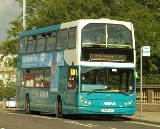
East Lancs Myllennium Lowlander
Encyclopedia
The East Lancs Myllennium Lowlander is the type of bus body built on the DAF/VDL DB250
chassis by East Lancashire Coachbuilders
.
. The Lowlander was also the East Lancs body for the DAF DB250, but in 2000, was given a facelift with East Lancs' "Myllennium" design. This is what gave the Lowlander its new name the Myllennium Lowlander.
VDL DB250
The VDL DB250 is a double-decker bus sold in the UK through VDL Bus International's UK dealer Arriva Bus & Coach. A small number of DB250s have also been exported to Istanbul, Turkey.-DB250:...
chassis by East Lancashire Coachbuilders
East Lancashire Coachbuilders
East Lancashire Coachbuilders Limited was a manufacturer of bus bodies and carriages founded in 1934 in Blackburn, Lancashire, England.In 1994 the company expanded in to new premises and commenced a programme of development that resulted in a range of single and double deck buses which was the...
.
History
The Myllennium Lowlander superseded the East Lancs LowlanderEast Lancs Lowlander
The East Lancs Lowlander was the type of double-decker bus planned by East Lancashire Coachbuilders. It would have been the double-deck version of the Spryte. It was going to be the name of the body built on the DAF/VDL DB250 chassis, along with the similar Vyking and East Lancs Lolyne on the Volvo...
. The Lowlander was also the East Lancs body for the DAF DB250, but in 2000, was given a facelift with East Lancs' "Myllennium" design. This is what gave the Lowlander its new name the Myllennium Lowlander.

